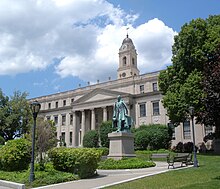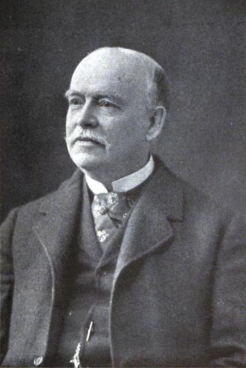
Josiah Cleaveland Cady was an American architect known for his Romanesque Revival designs. He was also a founder of the American Institute of Architects.

George Browne Post, professionally known as George B. Post, was an American architect trained in the Beaux-Arts tradition. Active from 1869 almost until his death, he was recognized as a master of several prominent contemporary American architectural genres, and instrumental in the birth of the skyscraper.
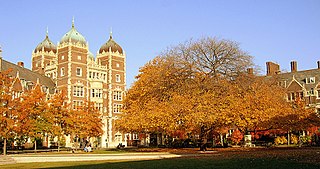
Cope and Stewardson (1885–1912) was a Philadelphia architecture firm founded by Walter Cope and John Stewardson, and best known for its Collegiate Gothic building and campus designs. Cope and Stewardson established the firm in 1885, and were joined by John's brother Emlyn in 1887. It went on to become one of the most influential and prolific firms of the late-nineteenth and early-twentieth centuries. They made formative additions to the campuses of Bryn Mawr College, Princeton University, the University of Pennsylvania, and Washington University in St. Louis. They also designed nine cottages and an administrative building at the Sleighton School, which showed their adaptability to other styles, because their buildings here were Colonial Revival with Federal influences. In 1912, the firm was succeeded by Stewardson and Page formed by Emlyn Stewardson and George Bispham Page.

Horace Trumbauer was a prominent American architect of the Gilded Age, known for designing residential manors for the wealthy. Later in his career he also designed hotels, office buildings, and much of the campus of Duke University.

The J. J. Bridges House is a historic house located at 704 South Kuhl Avenue in Orlando, Florida. It is locally significant as the first of the highly academic Colonial Revival style homes built in the city.

The Mutual Benefit Life Insurance Company was a life insurance company that was chartered in 1845 and based in Newark in Essex County, New Jersey, United States. The company was headed by Frederick Frelinghuysen (1848–1924). The company was known as the "Tiffany" of insurance companies, a reference to its reputation as the life insurance company to the upper classes.
George Edward Krug was an American architect who practiced in Greater New York City, São Paulo, Brazil and Orlando, Florida.

Wilson Brothers & Company was a prominent Victorian-era architecture and engineering firm based in Philadelphia, Pennsylvania. The company was regarded for its structural expertise.
KBJ Architects, Inc. (KBJ) is an American architectural firm based in Jacksonville, Florida. The firm designed 17 of the city's 30 tallest buildings and "created Jacksonville's modern skyline", according to The Florida Times-Union newspaper. The firm designed the first high-rise in downtown Jacksonville, the 22-story Aetna Building, which opened in 1955. It took pride in "having the second-largest number of architects of any Florida firm", according to a 1997 article in The Florida Times-Union.
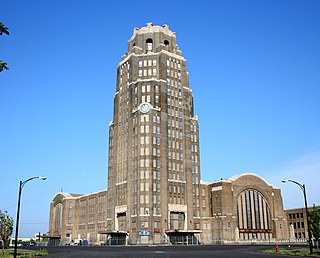
Alfred T. Fellheimer was an American architect. He began his career with Reed & Stem, where he was lead architect for Grand Central Terminal. Beginning in 1928, his firm Fellheimer & Wagner designed Cincinnati Union Terminal.

The National Newark Building is a neo-classical office skyscraper in Newark, New Jersey. It has been the tallest building in Newark since 1931 and was tallest in New Jersey until 1989. At thirty-five stories, it has a height of 466 ft (142 m). It is located in the heart of Downtown Newark at 744 Broad Street, just north of Four Corners.
Jeremiah O'Rourke, FAIA,, was an Irish-American architect known primarily for his designs of Roman Catholic churches and institutions and Federal post offices. He was a founder of the Newark-based architectural firms of Jeremiah O'Rourke and Jeremiah O'Rourke & Sons.

Grad Associates, formerly Grad Partnership and Frank Grad & Sons, was an architectural firm based in Newark, New Jersey. Founded in 1906 by Frank Grad (1882–1968), the company was later run by his sons, Bernard and Howard. The company closed its doors on February 19, 2010.
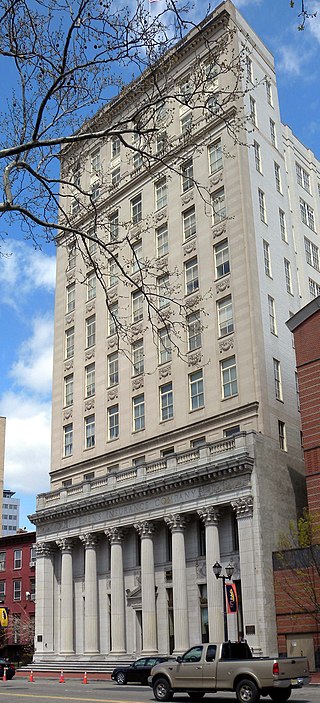
The Home Office Building is located adjacent to Military Park at 10 Park Place in Newark, Essex County, New Jersey, United States. The building was built in 1928 and was added to the National Register of Historic Places on June 17, 1982.

The Four Corners Historic District is the intersection of Broad and Market Streets in Newark, New Jersey. It is the site of the city's earliest settlement and the heart of Downtown Newark that at one time was considered the busiest intersection in the United States. The area that radiates twenty-two square blocks from the crossroads is a state and federal historic district.
Prudential Financial is based in Newark, New Jersey. It began as The Widows and Orphans Friendly Society in 1875, and for a short time it was called the Prudential Friendly Society. For many years after 1877 it was known as the Prudential Insurance Company of America, a name still widely in use. The company has constructed a number of buildings to house its offices in downtown in the Four Corners district. In addition to its own offices, the corporation has financed large projects in the city, including Gateway Center and Prudential Center. Prudential has over 5,000 employees in the city.

Frank J. Nies was an American architect best known for having designed numerous Delaware, Lackawanna and Western Railroad stations, at least fifteen of which have been listed on the U.S. National Register of Historic Places : He sometimes worked with the railroad's chief engineer, Lincoln Bush. Before working for the Delaware, Lackawanna & Western, Nies was a partner in the architectural firm Finkler & Nies, with Adolph Finkler, in Chicago in 1896.

The American Insurance Company Building is one of the oldest and tallest skyscrapers in Newark, Essex County, New Jersey, United States. Located at 15 Washington Street on Washington Park it was once headquarters for the American Insurance Company and is now part of Rutgers University. The neo-classical tower is a contributing property to the James Street Commons Historic District which also encompasses Washington Park, Newark Museum, and Newark Public Library. It re-opened in November 2015 as student dorms, event space, and chancellor's apartment. In 2023 it was renamed in honor of Ruth Bader Ginsburg.
